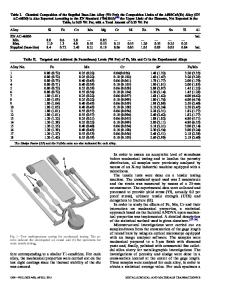A Methodology to Predict the Effects of Quench Rates on Mechanical Properties of Cast Aluminum Alloys
- PDF / 487,195 Bytes
- 7 Pages / 593.972 x 792 pts Page_size
- 64 Downloads / 404 Views
ODUCTION
THE heat treatment of aluminum alloys usually involves three steps: solutionizing, quenching, and aging. Depending on the cooling rate in the quenching process, precipitates can heterogeneously nucleate at the grain or phase boundaries or at any available defects present in the a-aluminum matrix. This kind of precipitation can result in reduction of supersaturation of the solid solution, which decreases the ability of the alloy to develop the maximum properties attainable with the subsequent aging treatment. A quantitative measurement of the properties resulting from different cooling rates is needed for the quenching process design.[1] Quench factor analysis, developed by Evancho and Staley, was able to quantify the variation in properties due to different cooling rates.[1] SHUHUI MA, formerly with the Center for Heat Treating Excellence, Materials Science and Engineering, Worcester Polytechnic Institute, Worcester, MA 01609, is a New Product Development Engineer at Tiffany & Company, Cumberland, RI, USA 02864. Contact e-mail: [email protected] M.D. MANIRUZZAMAN, Research Assistant Professor, the Center for Heat Treating Excellence, Materials Science and Engineering, Worcester Polytechnic Institute, Worcester, MA, USA 01609. Contact e-mail: [email protected] R.D. SISSON, Jr., Professor and Director of Manufacturing and Materials Science & Engineeering Programs, the Center for Heat Treating Excellence, Materials Science and Engineering, Worcester Polytechnic Institute, Worcester, MA, USA 01609. D.S. MACKENZIE is with the Houghton International, Valley Forge, PA, USA. This article is based on a presentation made in the symposium ‘‘Simulation of Aluminum Shape Casting Processing: From Design to Mechanical Properties’’ which occurred March 12–16, 2006, during the TMS Spring meeting in San Antonio, Texas, under the auspices of the Computational Materials Science and Engineering Committee, the Process Modeling, Analysis and Control Committee, the Solidification Committee, the Mechanical Behavior of Materials Committee, and the Light Metal Division/Aluminum Committee. METALLURGICAL AND MATERIALS TRANSACTIONS B
Quench factor analysis has been applied to a wide range of wrought aluminum alloys to predict properties or to optimize industrial quenching procedures.[2–5] It is now recognized as an important technique for modeling property variation during continuous cooling. In order to use quench factor analysis for property prediction, the kinetic parameters of an aluminum alloy during quenching need to be experimentally estimated and verified. Interrupted quench, developed by Fink and Willey,[6] was traditionally employed by the researchers to collect the experimental data including the thermal history of an alloy being studied and mechanical properties from the corresponding quenching process. Using the interrupted quench technique, Dolan et al. determined the kinetic parameters for 7175-T73 based on hardness, electrical conductivity, and tensile strength.[7,8] Staley gave an example of using the quench factor ana
Data Loading...










